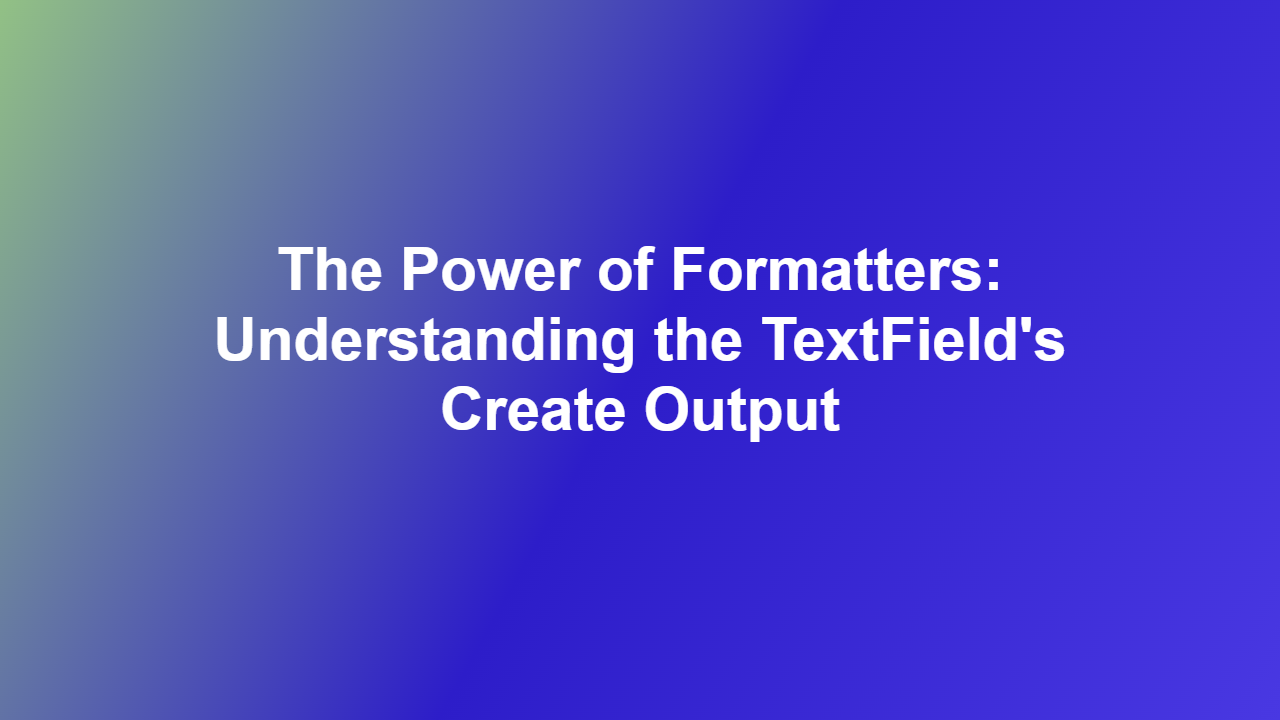The Power of Formatters: Understanding the TextField’s Create Output
Introduction
In software development, especially when building user interfaces, formats are crucial to ensure that data is presented in a clear, readable, and visually appealing manner. One essential tool used to create and manage formats is the `TextField`. This fundamental UI component allows users to enter and display text data in various formats. However, have you ever wondered what is typically created by a `TextField`, and how you can leverage its power to enhance your application’s user experience?
What is a Formatter?
A formatter is a functionality that transforms text data from a raw or unformatted state into a predefined style or structure. Formatters are used extensively in `TextViews` and `TextInputs`, such as the familiar `TextField`. By utilizing a formatter, developers can capitalize on automated formatting features to streamline their coding process.
Types of Formatters
There are several types of formatters that can be used in a `TextField`, including:
– Text trimmer: Removes leading or trailing whitespace from text input.
– Email formatter: Formats the email address according to a specific pattern, ensuring the format is consistent and follows standard guidelines.
– Currency formatter: Displays numerical values as formatted currency, with options to adjust the number of decimal places, group separators, and more.
Code Example: Text Formatting
“`java
import android.os.Bundle;
import android.text.Editable;
import android.text.TextWatcher;
import android.widget.EditText;
import androidx.appcompat.app.AppCompatActivity;
public class TextFormatActivity extends AppCompatActivity {
private EditText editText;
@Override
protected void onCreate(Bundle savedInstanceState) {
super.onCreate(savedInstanceState);
setContentView(R.layout.activitytextformat);
// Initialize the editText view
editText = findViewById(R.id.editText);
// Set up the text watcher to format text in real-time
editText.addTextChangedListener(new TextWatcher() {
@Override
public void beforeTextChanged(CharSequence charSequence, int i, int i1, int i2) {}
@Override
public void onTextChanged(CharSequence charSequence, int i, int i1, int i2) {}
@Override
public void afterTextChanged(Editable editable) {
// Format the text using the TextCapSentences and TextAllCaps formatters
editText.setGravity((CharSequence) R.styleable.TextViewandroidgravity);
editText.setHint(R.string.formatted_text);
}
});
}
}
“`
Why Use Formatters?
Formatters bring numerous benefits to your application, including:
– Consistency: Automated formatting ensures that data is presented uniformly throughout the app.
– Simplified coding: With formatters, developers focus on more complex aspects of app functionality.
– Improved user experience: Clean, formatted text enhances the overall UI and helps users navigate data efficiently.
Conclusion
In this article, we explored the world of formatters and how `TextFields` are used to create them. By leveraging formatters, developers can create a cohesive, well-organized user interface that attracts and retains users.
FAQs
1. What is the primary purpose of a formatter in a TextField?
The primary purpose of a formatter in a `TextField` is to automatically transform text data into a predefined style or structure, ensuring consistency in formatting throughout the application.
2. Can I customize the formatting options in a TextField?
Yes, most formatters allow you to customize various aspects of formatting, such as numerical value representation, whitespace removal, and text alignments.
3. Will I need to write code to implement formatters in my application?
In most cases, formatters are built into your chosen programming framework (e.g., Android), so you can usually implement them simply by integrating the relevant UI components, such as a `TextField`.
4. What types of data formats can be created with a TextField?
Using a `TextField`, you can create various data formats, including email addresses, currencies, and more, depending on the type of formatter utilized.
5. How can formatters benefit the user experience in an application?
By automatically formatting text data, formatters enhance the overall user experience by providing clean, well-organized, and consistently structured data throughout the application.
Whether you’re a seasoned developer or just starting to explore the world of UI components, understanding the power of formatters will undoubtedly make your development process easier, more efficient, and enjoyable.
